Alice Y. Chen's Blog, page 8
September 22, 2015
Two worlds collide
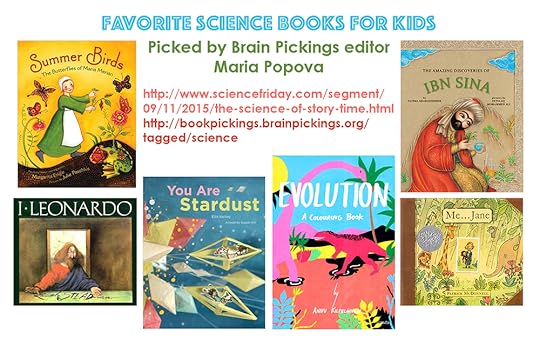
This is a slight departure from my Centipede Dragon-centric posts. But I do want to highlight this recent radio show from September 11, 2105:
Every once in a while my universes align, as it did that week on Science Friday, a 2-hour radio show produced out of New York where all topics are on, you guessed it, SCIENCE! This time, however, my two passions collided, producing a baby in the form of a show about science books for kids! So, now that the kids are BACK in school, I wanted to plug this podcast, and the websites of the guests who recommended some books to check out. Could get some great book reports and even a love of science, to boot.
My goal is to take a few of these books and talk a little more in-depth about them, starting with "Summer Birds," which I currently have my hands on. There's a lot of potential to introduce little known scientists and pioneers to a new generation.
Here's the first batch. Check out editor Maria Popova's Brain Pickings site while you're at it, for books for the adults!
Published on September 22, 2015 05:33
September 15, 2015
Considering the right side of history.
A while back I talked about character development for Ben and Ariel. I had struggled over their ethnicity because a member of my children’s book group lobbied that my characters be Asian, to be consistent with the origin of Centipede Dragon. I was reticent to this idea right up until the point of my “Speak now…” moment, because minority kid books don’t sell in today's market. Furthermore, I thought the universality of the message in my book would be lost, for once I made the kids Asian, my book would likely be categorized very narrowly. You may think me paranoid, but since officially publishing my book, I have been told by an indie bookstore that my book won’t sell because it’s a folktale. Uh, but it’s NOT a folktale!
Much as we like to think we live in a color-blind society, we in fact do not. Pre-conceived notions about a book are made based on who wrote it and who's in it. If it’s a book with Asian kids, the presumption is that it must be about Asian culture; it can’t simply be about a child who happens to BE a minority, facing a problem that any kid could face. People think there has to be a reason that the kid is Asian. So, making my characters non-descript–in order to appeal to a broader market–seemed the wiser choice.
As I came to terms with self-publication, the reality of my legacy left with this book truly hit home. Why did I really choose to publish under my maiden name? Legacy, I had declared! But why was it important to me to be recognized as an Asian?
Today I have a better understanding of what it means to be Asian in a non-Asian society. This was hard to come by, because there were no positive models for me, in books or elsewhere.
I didn’t want to perpetuate the problem. I wanted to be part of the solution.
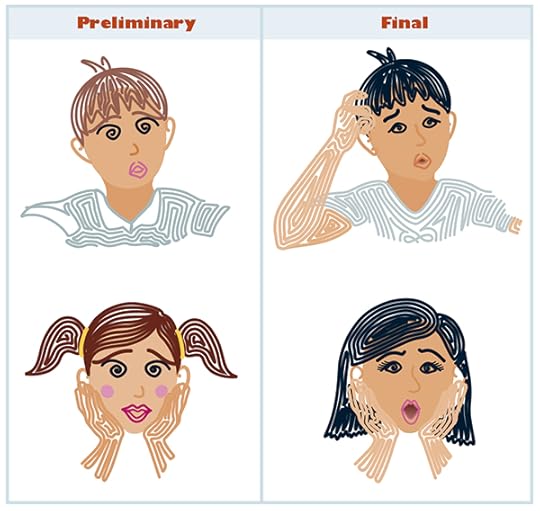
Much as we like to think we live in a color-blind society, we in fact do not. Pre-conceived notions about a book are made based on who wrote it and who's in it. If it’s a book with Asian kids, the presumption is that it must be about Asian culture; it can’t simply be about a child who happens to BE a minority, facing a problem that any kid could face. People think there has to be a reason that the kid is Asian. So, making my characters non-descript–in order to appeal to a broader market–seemed the wiser choice.
As I came to terms with self-publication, the reality of my legacy left with this book truly hit home. Why did I really choose to publish under my maiden name? Legacy, I had declared! But why was it important to me to be recognized as an Asian?
Today I have a better understanding of what it means to be Asian in a non-Asian society. This was hard to come by, because there were no positive models for me, in books or elsewhere.
I didn’t want to perpetuate the problem. I wanted to be part of the solution.

Published on September 15, 2015 05:01
September 8, 2015
The first step is always the hardest.
I have to say that I have a phenomenal support network, people who must really like me and believe in my creativity. If it weren’t for these people’s feedback and encouragement, I’m not sure how I’d feel about having gone down this self-publishing road. Because frankly I would’ve done it either way, but the sheer enthusiasm, positivity and cheerleading that all of you have done for me have tipped the scales toward the “Glad I did it” camp.
So I was at that fork in my road, and honestly was tired of waiting for someone else to “sanction” my work. So, one February day I mentally sallied forth, leaving my logical flow chart behind.
As far as this whole children’s book writing/illustrating process has gone to date, I shouldn’t have expected this stage to be any less convoluted. For instance, the “speak-now-or-forever-hold-peace” part of this decision was only just beginning. Issues began to burble up again: am I completely content with my content? Are there any last gaps in the way I’ve told the story? Was each and every design and illustration decision sound enough for me to look at in 5-10 years from now, and still feel OK about them?
This was the time to take a very sterile look at my work. If I were to pick this book up at a bookstore and thumb through it, what would I think were its weakest features? What would I suggest to the author to change?
By far the most difficult and most taxing change will be revealed in the next post. Can you guess what it was?
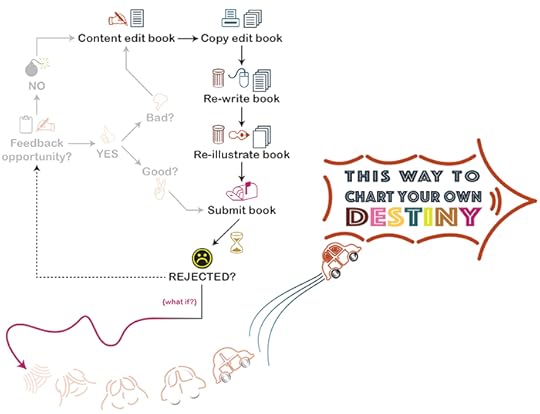
So I was at that fork in my road, and honestly was tired of waiting for someone else to “sanction” my work. So, one February day I mentally sallied forth, leaving my logical flow chart behind.
As far as this whole children’s book writing/illustrating process has gone to date, I shouldn’t have expected this stage to be any less convoluted. For instance, the “speak-now-or-forever-hold-peace” part of this decision was only just beginning. Issues began to burble up again: am I completely content with my content? Are there any last gaps in the way I’ve told the story? Was each and every design and illustration decision sound enough for me to look at in 5-10 years from now, and still feel OK about them?
This was the time to take a very sterile look at my work. If I were to pick this book up at a bookstore and thumb through it, what would I think were its weakest features? What would I suggest to the author to change?
By far the most difficult and most taxing change will be revealed in the next post. Can you guess what it was?

Published on September 08, 2015 05:18
September 1, 2015
Is there really any more info needed?

Some decisions are easy and others are hard. Some are critical and others, not. Am I in a beef or fish mood for dinner? Which software program should I devote a chunk of money and time to learning, that will get me my next job?
No matter what, decisions are always challenging in their own right. The cons may clearly outweigh the pros in some cases. But other factors, or pure instinct can sometimes count for double, triple, even quadruple points. And once you finally make your choice, any angst associated with it is gone, just like that...poof.
Looking back at my decision to self-publish, I won’t lie. I have questioned whether it was a good or poor one, depending on current location of pendulum. But what is certain is that it is now permanently checked off my Life’s “To-do” List. I had an idea, created a story, illustrated said story, and like Geppetto, I made it real.
As I did more research into self-publishing, I was reassured that the process and its abominable reputation had improved greatly since first looking into it years ago, before I even finished Centipede Dragon. Countless “Indie” authors pushed hard and sacrificed much to see this transformation occur. Numerous organizations formed to help support these independents who were earnestly striving to produce good quality books on their own. And finally, established trade organizations began to recognize the contributions that the self-published were making.
I read a lot of reviews about which self-publishers were the “best.” I then went to their sites and read a lot of forums to understand what kinds of problems/limitations they encountered during the production process. These forums provided a wealth of collective experience that the pioneers of self-publishing generously shared. It was invaluable to know how others’ rated their experiences, and if issues occurred, how the company “resolved” them. There was so much to consider already, and so I wanted to anticipate as many hiccups ahead of time as was possible.
I began to contemplate that soon, if I went down this road, my book would be a permanent entity. And if there were any outstanding issues left, any holes in the story, inconsistencies in the characters, flaws in the drawings or layout, ANYTHING at all, I needed to address them now.
Published on September 01, 2015 05:10
August 25, 2015
Misgivings and trepidations
Maybe three months had gone by in between receiving the editor feedback and the germination of the self-publishing idea. I had a ton of doubts when it came to self-publishing, foremost was its abysmal reputation. Self-publishing could make anyone a published author, but frankly, not everyone should be a published author. So with that great power came great abuse. Sloppy, un-edited, un-proofed work filled with type-o’s, mis-spelled words, incorrect grammar, and just plain bad writing, flooded the market. The tools these self-publishers offered to layout and design the book were also restrictive and frustrating, to put it kindly, but surprisingly many authors didn’t seem to care! Furthermore, the entire process was expensive. Hence the terrible reputation that the self-publishing industry earned had frankly been well-earned.
But that was also more than 5 years ago. A market filled with ill-quality product made consumers push back against the crap. Hip cafes sprouted up, where you could drop your manuscript off, get coffee, and then pick up your beautifully-published book. It became fashionable again to print high-quality work.
Most importantly, aspiring authors who cared so much about their work, demanded from the self-publishing industry the offering of better tools and more options to pay for printing better quality books. To stay viable, some self-publishing companies complied, and further offered “comprehensive” services to edit, design and market a book.
This has been an incredible time in the industry, with factors like e-books, Amazon, and the dwindling marketing/advertising budgets offered by traditional publishing houses, radically changing the face of the industry as a whole.
For me, the most influential factor weighing in on MY decision of what to do next, was that I was stuck. And not moving on.
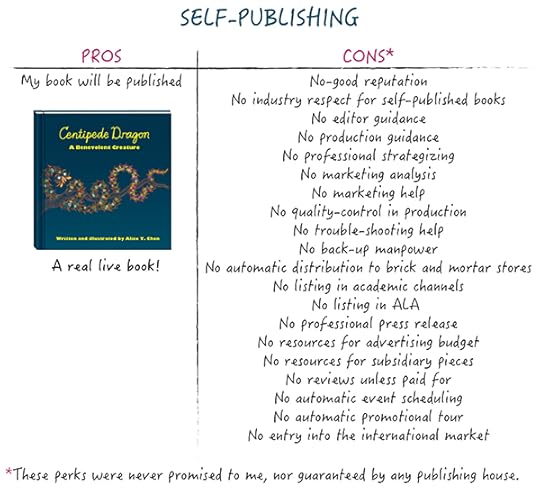
But that was also more than 5 years ago. A market filled with ill-quality product made consumers push back against the crap. Hip cafes sprouted up, where you could drop your manuscript off, get coffee, and then pick up your beautifully-published book. It became fashionable again to print high-quality work.
Most importantly, aspiring authors who cared so much about their work, demanded from the self-publishing industry the offering of better tools and more options to pay for printing better quality books. To stay viable, some self-publishing companies complied, and further offered “comprehensive” services to edit, design and market a book.
This has been an incredible time in the industry, with factors like e-books, Amazon, and the dwindling marketing/advertising budgets offered by traditional publishing houses, radically changing the face of the industry as a whole.
For me, the most influential factor weighing in on MY decision of what to do next, was that I was stuck. And not moving on.

Published on August 25, 2015 05:36
August 18, 2015
How to make a book
After my editor-feedback encounter, I decided to assess my situation. I had been submitting Centipede Dragon to publishing companies for two years without feedback for its rejection. I had tested the book out on my actual target audience with rave reviews in return. I had incorporated numerous suggested changes to both text and imagery from anyone willing to give me honest opinions. I had constantly striven to make the book the best it could be, to the best of MY capability. But the bottom line is, I’m not in publishing, and I don’t KNOW what it takes to make a successful book. What I had was a story and the desire to tell it. And no matter how much I read or how many conferences I attend, nothing substitutes for real experience.
I admit it, I don’t know what sells. I frankly thought a half-this, half-that creature would be a great hook, not to mention the magical thing. If I figured the insect-dragon thing could catch the boys while the strong, girl character Ariel character and sensitive nature of the story could hook the girls. But no one in the industry was seemingly agreeing. So, if no publishing expert will provide any specific direction, what do I do?
At this point, I was tired and frustrated. I almost wished for blunt feedback:
“Look, your story is boring and predictable,”
“Your illustrations reveal your deficits in artistic training.”
I wanted a clue, a sign that would signal me to just let it go.
In the course of my many searches for traditional publishers to submit to, a whole host of self-publishers kept cropping up along with them. E-publishers like Smashwords were being profiled on NPR’s “All Things Considered” as the leader in the next generation of publishing, and so this tiny seed of an idea sprouted to mind. I had not considered self-publishing to this point, but was the time to look into it now?
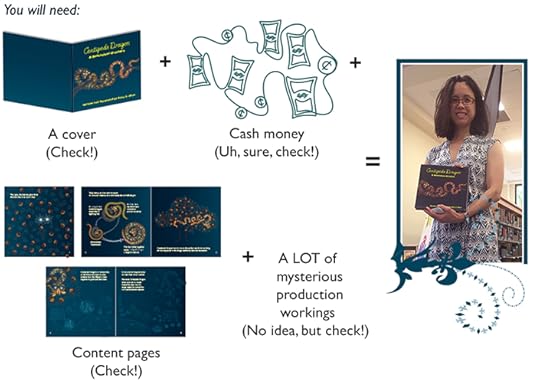
I admit it, I don’t know what sells. I frankly thought a half-this, half-that creature would be a great hook, not to mention the magical thing. If I figured the insect-dragon thing could catch the boys while the strong, girl character Ariel character and sensitive nature of the story could hook the girls. But no one in the industry was seemingly agreeing. So, if no publishing expert will provide any specific direction, what do I do?
At this point, I was tired and frustrated. I almost wished for blunt feedback:
“Look, your story is boring and predictable,”
“Your illustrations reveal your deficits in artistic training.”
I wanted a clue, a sign that would signal me to just let it go.
In the course of my many searches for traditional publishers to submit to, a whole host of self-publishers kept cropping up along with them. E-publishers like Smashwords were being profiled on NPR’s “All Things Considered” as the leader in the next generation of publishing, and so this tiny seed of an idea sprouted to mind. I had not considered self-publishing to this point, but was the time to look into it now?

Published on August 18, 2015 05:35
August 11, 2015
SCBWI and Magical seeds
One of the great benefits of being an SCBWI (Society of Children’s Book writers and Illustrators) member is the myriad of opportunities to meet editors, agents, published authors and aspiring authors at conferences. You have the chance to tell them about yourself, and what your dream idea is. You see their eyes light up when you tell them what you have been working on. And most of all, they see you as someone truly serious about becoming published, simply because you are there.
I had one such opportunity to e-mail my book in its entirety to a senior editor of a well-known company. In the accompanying e-mail I extolled its virtues as usual, and two weeks later this editor wrote back:
“I love your vivid and creative artwork, but I'm afraid this work is not quite right for my list […]. I wish I could give you more specific feedback but the tremendous number of stories that I receive […] make that difficult.”
So…what does this mean? The first part sounds good, positive, right? Then it’s followed by the knock-down of rejection.
Looking back at that flow chart from the last post, the negative feedback arrow leads back to “Content edit the book.” Can YOU figure out from the editor’s response what I should change? What am I editing: the character development, the plot’s set-up or its resolution? What if I edit out what she considered to be the very best passage? What if I unknowingly delete her favorite image thinking it was the weak one? Did she like or dislike the cheeky sheep? So, how do I improve the work in this vacuum of non-criticism and non-direction?
My flow chart has failed me in today’s publishing industry. So what’s an aspiring author/illustrator to do?

I had one such opportunity to e-mail my book in its entirety to a senior editor of a well-known company. In the accompanying e-mail I extolled its virtues as usual, and two weeks later this editor wrote back:
“I love your vivid and creative artwork, but I'm afraid this work is not quite right for my list […]. I wish I could give you more specific feedback but the tremendous number of stories that I receive […] make that difficult.”
So…what does this mean? The first part sounds good, positive, right? Then it’s followed by the knock-down of rejection.
Looking back at that flow chart from the last post, the negative feedback arrow leads back to “Content edit the book.” Can YOU figure out from the editor’s response what I should change? What am I editing: the character development, the plot’s set-up or its resolution? What if I edit out what she considered to be the very best passage? What if I unknowingly delete her favorite image thinking it was the weak one? Did she like or dislike the cheeky sheep? So, how do I improve the work in this vacuum of non-criticism and non-direction?
My flow chart has failed me in today’s publishing industry. So what’s an aspiring author/illustrator to do?

Published on August 11, 2015 05:46
August 4, 2015
Flow charts
As an illustrator, I often rely on imagery to help me convey what I am trying to do via words. Though I LOVE to write, it does NOT come naturally and therefore I struggle with it, draft after draft after agonizing draft. In contrast, illustrations are constantly popping into my head at all hours of the day and night, and sometimes I can’t draw fast enough to keep up.
So, I created this visual flow chart to demonstrate the repetitive nature of this book publishing process. What the take home point is, is that re-editing content, re-copy-editing, re-writing and re-illustrating happens over and over as we creative persons try to assess what might not have been working with our manuscripts and illustrations, that garnered the latest rejection. Of course there are phenoms like Oliver Jeffers who send out to the top ten publishing companies and get the huge bite in the first round. I’m the first in line to acknowledge his genius in both storytelling and illustrating, but also to say that there are many other talented authors out there who frankly don’t experience this process in that way.
So when the time comes for you to enter this loop, always keep in mind that it’s all about faith in your work, faith in your message and faith in yourself.
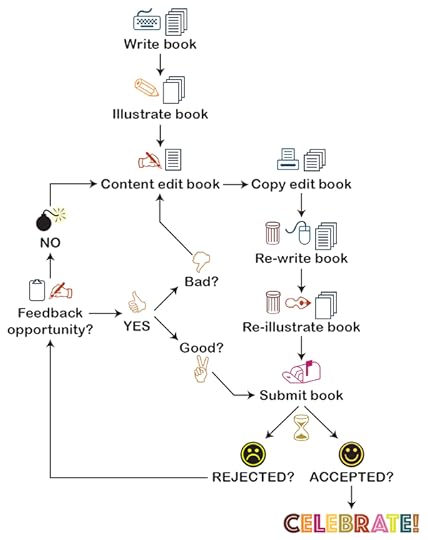
So, I created this visual flow chart to demonstrate the repetitive nature of this book publishing process. What the take home point is, is that re-editing content, re-copy-editing, re-writing and re-illustrating happens over and over as we creative persons try to assess what might not have been working with our manuscripts and illustrations, that garnered the latest rejection. Of course there are phenoms like Oliver Jeffers who send out to the top ten publishing companies and get the huge bite in the first round. I’m the first in line to acknowledge his genius in both storytelling and illustrating, but also to say that there are many other talented authors out there who frankly don’t experience this process in that way.
So when the time comes for you to enter this loop, always keep in mind that it’s all about faith in your work, faith in your message and faith in yourself.

Published on August 04, 2015 05:08
July 29, 2015
Wrap-up of July 23rd’s presentation at Mount Vernon Park
We had ridiculously beautiful weather at the park last Thursday. I was attempting a new format for the Magical Scale Challenge for two reasons: 1) Since the kids were eager to play the game at my previous event, I figured I should let them play (and make them do all the work), and 2) I didn’t have a large white-board at my disposal.
With kids, you really just need to show them once, and then, they bring their own flair. After all the times I have performed this challenge, I was floored by the unique perspective these kids brought to each word challenge, and by their desire to add rules to make the game more challenging.
The biggest surprise came with the challenge “hat.” Lily, one of my older competitors, was doing a fine job with the décor she was adding to her hat. But I kept looking at the bottom of her board and wondering why she wasn’t closing up that bottom edge of the hat. After all, the brim has a bottom edge, right?
You see from the picture just WHY she didn’t close it up. She also made up rules as she went along, and so next time, watch out. This game is simply NOT just for kids anymore.
Thanks to my friend Gretchen and to James of the Mount Vernon Park Association, who helped organize this event.
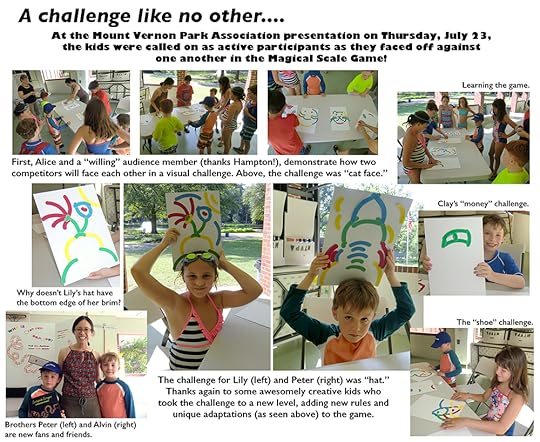
With kids, you really just need to show them once, and then, they bring their own flair. After all the times I have performed this challenge, I was floored by the unique perspective these kids brought to each word challenge, and by their desire to add rules to make the game more challenging.
The biggest surprise came with the challenge “hat.” Lily, one of my older competitors, was doing a fine job with the décor she was adding to her hat. But I kept looking at the bottom of her board and wondering why she wasn’t closing up that bottom edge of the hat. After all, the brim has a bottom edge, right?
You see from the picture just WHY she didn’t close it up. She also made up rules as she went along, and so next time, watch out. This game is simply NOT just for kids anymore.
Thanks to my friend Gretchen and to James of the Mount Vernon Park Association, who helped organize this event.

Published on July 29, 2015 05:28
July 24, 2015
Bonus Post
Yesterday afternoon’s presentation was yet another chance for me to beta test a new format for the Magic Scale Game, and here are two of my willing participants. Kids will always surprise you with their depth of creativity. Next week’s post will give the usual summary of our event.
Thanks so much to the Mount Vernon Park Association for having me. What a beautiful day it was!
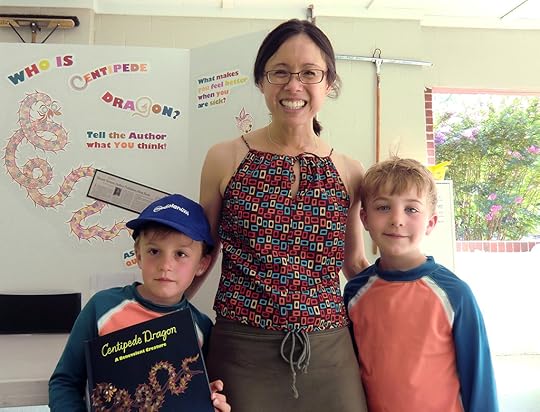
Thanks so much to the Mount Vernon Park Association for having me. What a beautiful day it was!

Published on July 24, 2015 06:18



